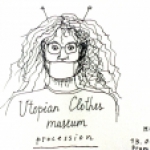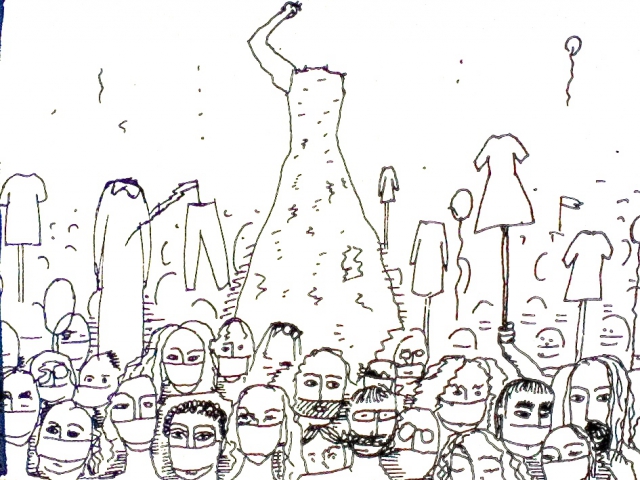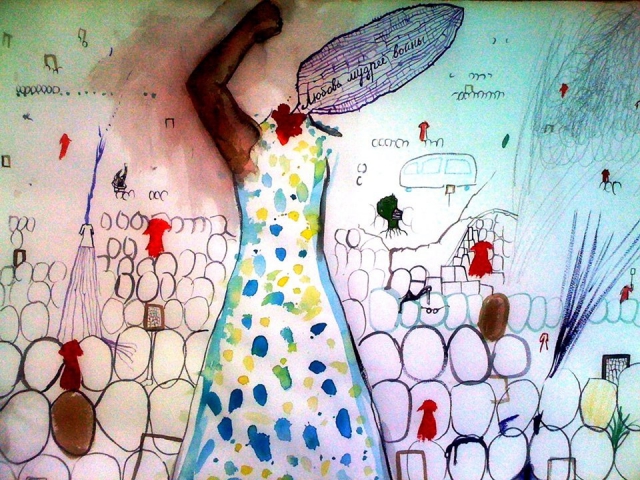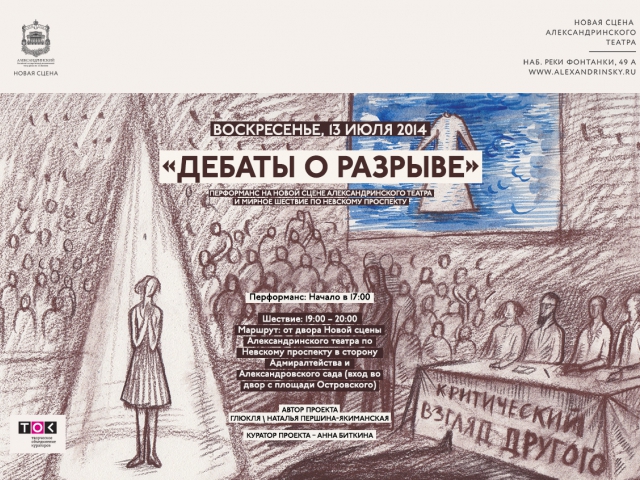Debates on Division: When the Private Becomes Public’

July 13, 2014
‘Debates on Division: When the Private Becomes Public’ Performance and a silent procession along Nevskiy Prospekt
Artist: Gluklya (Natalia Petshina-Yakimanskaya) Curator: Anna Bitkina
Venue: Alexandrinskiy Theater, New Stage Address: Fontanka Embankment, 49 A, Metro Gosninuy Dvor
Performance: 17.00-19.00
Procession: 19.00-20.00 (procession starts from inside a courtyard of The Alexandrinskiy Theater, New stage and will continue alongside Nevskiy Prospekt towards Alexandrovskiy Garden and Admiralteysvo)
‘Debates on Division: When the Private Becomes Public’
‘Debates on Division: When the Private Becomes Public’ is an interactive performance about political , social and ideological divisions as well as about the position of the individual amidst those conflicts. The performance begins with an action at the New Stage of the Aleksandrinsky Theatre and continues with a silent procession along Nevskiy Prospekt. ‘Debates on Division’ will set up possible directions for thoughts, reflections and an analysis of the current socio-political situation both inside and outside Russia to develop in.
The first part of the performance consists of several staged video stories by people who will speak about pieces of clothing that have a connection to significant events in their lives. The performance will unite St Petersburg citizens of different ages, social status and nationalities selected by the project artist Natalia Pershina-Yakimanskaya (Gluklya). Their personal stories will bring to light important issues of Soviet and Russian history from unexpected sides. The performance will also touch upon problems that are connected to the shift of ideological regimes in Russia during the collapse of the Soviet Union.
In her projects, Gluklya often uses clothes as a tool to build a connection between art and everyday life. Addressing the personal stories of her characters, Gluklya analyses the relationship between the private and the public, exposing the conflict between the inner world of a person and the political system. ‘Debates on Division’ continues another project by Gluklya, the ‘Museum of Utopian Clothes’ that she started in 2012. This is a new form of museum that collects the stories of the ‘little man’. This format of the ‘museum for people’, where the position of an individual is honoured and respected, provides an equal space for people whose voice should be heard and whose story has historical value. Now the New Stage of The Alexandrinsky Theater will become the venue for an open discussion, organized in the form of a performance, and where stories for the ‘Museum of Utopian Clothes’ are selected. The main topics for the discussion will be the generation gap and the impact of public policy on people’s lives.
These comments on the stories about clothes will engаge performance participants, the audience, the invited jury, and a panel of experts, and could serve as a means to collectively re-experience recent historical events. The jury and panel of experts consist of representatives of the St Petersburg and Moscow art scenes, including artists, curators, philosophers, activists, poets, social scientists, and journalists.
They will comment on and evaluate the presented stories. The commentary of the experts will help to draw a wider socio-political picture of post-soviet Russia into which the presented stories will be incorporated. The audience, too, will be invited to take part in the discussion and vote for their selection from the presented clothes. This collective selection of historical artefacts for the ‘Museum of Utopian History’ makes the process of building a museum collection more alive, transparent, and democratic. The ‘Museum of Utopian Clothes’ exists in the form of an art project and aims to bridge the gap between the government and the citizenry. Such a museum could provide a model for how to form the policy of a governmental museum with the participation of city dwellers. According to the artist, this project promotes self-organizing initiatives among people and thereby сontributes to the formation of civil society in Russia.
Moving from the theater, the performance will continue with a procession along Nevskiy Prospekt towards Admiralteystvo. The procession will start in the courtyard of the theater and will engage everyone who is willing to participate. Information about the procession is widely distributed via Internet and social networks. In its second half the performance examines the ‘health conditions’ of Russians and the world community. Participants in the procession will be invited to put on medical protective masks. These masks cover the nose and mouth, which makes it difficult to breathe and speak. This metaphor reflects the current situation of censorship, abuse of human rights, and xenophobia in Russia.
A mask is also a protective device against a ‘contaminated’ environment, which symbolises the conflict between Russia and the West as well as the rupture inside Russian society. Recent events in Ukraine and the annexation of Crimea by Russia have rendered ideological and political division even more complicated. The seizure of foreign territory by the Russian government forced the leaders of Western countries to place a number of economic sanctions against Russia and impose visa restrictions on some members of the Russian government. The Western community, including the art world, expressed a certain disgust towards everything Russian and reluctance to ‘dirty their hands’ by touching anything connected with Russia, thus demonstrating ignorance of the details and nuances of local situation. However, the European curators of Manifesta 10, who by coincidence happened to be in Russia during the Russian-Ukrainian conflict, found themselves in a rather complicated situation. On the one hand, they had to withstand the pressure of the Western art community’s opposition to Russia and not tarnish their reputations. On the other hand - to continue to participate in a prestigious contemporary art project, made possible in part by Russian money.
The external and internal politics of the Russian government also divided Russian society into those who support it and those who stand opposed to its actions. Often, such a protest is expressed through strong reluctance to interact with the system of cultural, educational and social institutions, which are state-funded and are sometimes forced to adapt to the state machine and its ideology.
The authors of this project do not believe that boycotts and disregard are effective political tools. According to them, one of the ways to change the situation is to search for like-minded people within state institutions and cooperate with them. In their projects they use social practices to engage communities with the creative process. During such projects, participants develop an ability to understand the urge to articulate their needs and protect their right to resist irreversible changes in society. The ‘Debates on Division’ project united in a creative duo an artist, Natalia Pershina-Yakimanskaya (Gluklya), and a curator, Anna Bitkina, whose previous participatory practices and interactions with different communities and state institutions supplement each other.
In her projects Gluklya is guided by the principle that ‘The place of the artist is on the side of the weak’ * and creates situations when the voices of non-artists, non-heroes, and so-called ‘non-Russians’ are heard. An important element of Anna Bitkina's curatorial practice is social intervention in governmental institutions. Such a method serves as a tool to interact with a conservative governmental system in order to change it. While developing her projects, which often take places in public spaces and open areas of St. Petersburg, Anna is actively working on building relationships with employees of city administrations, as well as various committees and secondary schools. The collaboration with The New Stage of Alexandrinsky Theatre and various communities of St. Petersburg within the framework of the ‘Debate on Division’ project continues this work.
Anna Bitkina
-----
* The manifesto ‘The place of the artist is on the side of the weak' was written in 2002 by an artists duo Factory of Found Clothes (FFC), comprised by Natalia Pershina Yakimanskaya (Gluklya) and Olga Egorova (Tzaplya). The full text of the manifesto can be found at: www.factoryoffoundclothes.org
Project partners:
Creative Association of Curators TOK
New Stage of Alexandrinskiy Theater
European Biennale of Contemporary Art





